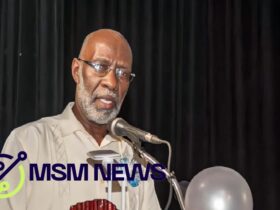Last week, World Bank Regional Vice-President for Latin America and the Caribbean, Carlos Felipe Jaramillo and Country Director for the Caribbean, Lilia Burunciuc, travelled to Guyana to engage with the Government of Guyana around the World Bank program.
Human capital is one of the pillars of the World Bank program in Guyana and the World Bank is one of Guyana’s main development partners on the education agenda. The Vice-President and Director had the opportunity to witness, first-hand, the impact of the joint Government of Guyana/World Bank education programming. The engagement in the education sector covers the entire sector and includes Technical and Vocational Education and Training (TVET), and the implementation of a new textbook policy.

During the visit, the Vice-President visited Good Hope Secondary School where he witnessed the integration of the Electronic Management Information System (EMIS) which connects school administrators with the central ministry, and he interacted with the staff on its use and operation. The World Bank Team included Mrs. Diletta Doretti, World Bank Resident Representative for Guyana and Suriname, and other staff of the World Bank. The Ministry of Education’s team was led by Mrs. Shannille Hoosein- Outar, Permanent Secretary, Ministry of Education, and included Regional Education Officer for Region 4 and Staff of the Good Hope Secondary School. Staff of the Ministry of Finance also joined the visit.
The World Bank team journeyed to Region 9 where they were welcomed by the Regional Executive Officer and other staff of the Regional Democratic Council. While in the region, the team paid a visit to the “Smart Room” at the Arapaima Primary school in Lethem, where they saw how digital platforms are being used to bridge the education gap between coastal and hinterland schools. The World Bank team also visited the Parishara Nursery School to see the rollout of the renewed nursery curriculum, and how indigenous materials and content are being incorporated into teaching and learning with the renewed curriculum.

Accompanying the team in the Region from the Ministry of Education were Deputy Chief Education Officer with responsibility for Amerindian Hinterland Education Development (AHED) Mr. Marti De Souza, Chief Planning Officer Ms. Tonnica Archer, Project Coordinators Mr. Rovin Sukhraj and Mr. Patrick John, and other staff of the Project Implementation Unit.







Leave a Reply